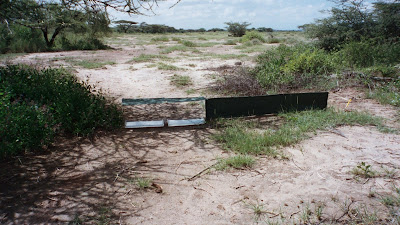


This is a series of photos of some of my angled-pane traps being used to collect flying insects in Kenya and Tanzania in 2002. Angled-pane traps are of my own design and differ from standard pane traps in that the flight-intercept pane (made from plexiglass) is mounted close to a 45 degree angle to the vertical rather than being vertically mounted. The idea is that an angled pane improves the catch of faster flying insects - including the spheciform wasps that I study - compared with the catch of standard pane traps. Each trap includes a rectangular parasol that shades the base of the trap to decrease the amount of light reflected by the angled pane, thereby increasing trap effectiveness. The green fabric fences to the sides of the traps channel the insects toward the traps, often multiplying the catch considerably. Flying insects are deflected into soapy water contained by a plexiglass tray that forms the base of the trap.
The kids and I will design an experiment to compare the effectiveness of the angled-pane trap with a standard pane trap. It's already clear that the trap works very well and produces samples that differ significantly in faunal diversity compared with my own aerial netting done at the same time and place. For example, during a collecting trip to Kenya, a large series of females of a new species of Tachysphex were first collected with this trap in an area that Dr. Pulawski and I had already sampled with aerial nets.
No comments:
Post a Comment